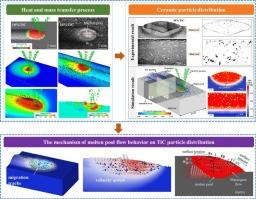激光定向能沉积钛基复合材料流动特性和颗粒迁移行为的多物理场建模
IF 6.8
1区 工程技术
Q1 ENGINEERING, MANUFACTURING
引用次数: 0
摘要
在激光定向能沉积(DED)过程中,将陶瓷颗粒加入钛合金中可显著提高机械性能。然而,颗粒在熔池中的迁移行为以及陶瓷颗粒对流动特性的影响仍不清楚。在此,我们开发了一个多物理场模拟模型,用于研究 TiC/Ti6Al4V 钛基复合材料熔池与未熔化陶瓷颗粒之间的相互作用机制。该模型采用了计算流体动力学和离散元方法(CFD-DEM)的耦合。通过进行 DED 实验,比较了熔池的横截面和高速照片,验证了我们模型的有效性。模拟结果表明,TiC 增强粒子的浓度对温度分布和速度场都有很大影响。增加 TiC 的含量会加快激光能量的吸收,最终导致峰值温度升高。此外,TiC 含量的增加导致熔融粘度升高,阻碍了马兰戈尼流动。同时,TiC 颗粒的迁移主要受马兰戈尼对流的影响。TiC 陶瓷颗粒主要分布在沉积层的上部和下部区域,颗粒分布与颗粒进入熔池的位置密切相关。这些发现为了解采用 DED 技术的增材制造过程中金属基复合材料的多相动力学提供了宝贵的见解。本文章由计算机程序翻译,如有差异,请以英文原文为准。

Multiphysics modeling of flow characteristics and particulate migration behavior of titanium matrix composites by laser directed energy deposition
Incorporating ceramic particles into titanium alloys during the laser directed energy deposition (DED) process has been shown to significantly enhance the mechanical properties. However, particulate migration behavior within the melt pool and the influence of ceramic particles on the flow characteristics remain unclear. Here, we developed a model for multiphysics simulations to investigate the interaction mechanisms between molten pool and unmelted ceramic particles of TiC/Ti6Al4V titanium matrix composites. This model employs a coupling of computational fluid dynamics and the discrete element method (CFD–DEM). The effectiveness of our model was verified by comparing the transverse sections and high-speed photographs of the molten pool by conducting DED experiments. The simulation findings suggest that the concentration of TiC reinforcing particles greatly influences both the temperature distributions and velocity fields. Increasing the content of TiC resulted in faster absorption of laser energy, ultimately leading to an increase in peak temperature. Additionally, the augmentation of TiC content resulted in elevated molten viscosity, which impeded Marangoni flow. Meanwhile, the migration of TiC particles is mainly influenced by Marangoni convection. TiC ceramic particles were predominantly distributed within the upper and lower regions of the deposition layer, and the particle distribution is closely related to the position of particles entering the molten pool. These findings offer valuable insights into the multiphase dynamics of metal matrix composites during the additive manufacturing process employing DED technology.
求助全文
通过发布文献求助,成功后即可免费获取论文全文。
去求助
来源期刊

Journal of Manufacturing Processes
ENGINEERING, MANUFACTURING-
CiteScore
10.20
自引率
11.30%
发文量
833
审稿时长
50 days
期刊介绍:
The aim of the Journal of Manufacturing Processes (JMP) is to exchange current and future directions of manufacturing processes research, development and implementation, and to publish archival scholarly literature with a view to advancing state-of-the-art manufacturing processes and encouraging innovation for developing new and efficient processes. The journal will also publish from other research communities for rapid communication of innovative new concepts. Special-topic issues on emerging technologies and invited papers will also be published.
 求助内容:
求助内容: 应助结果提醒方式:
应助结果提醒方式:


